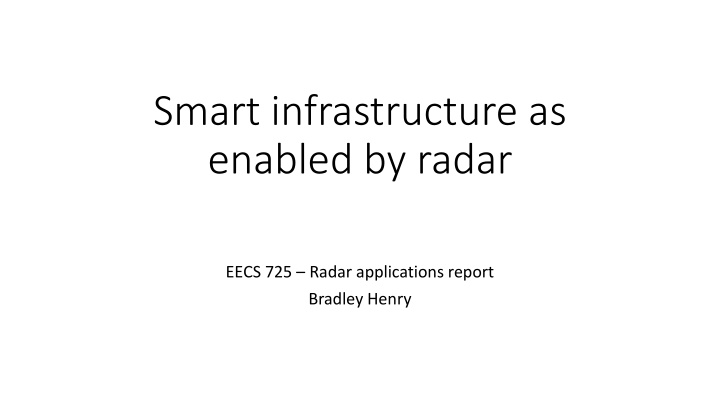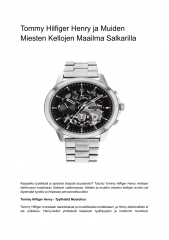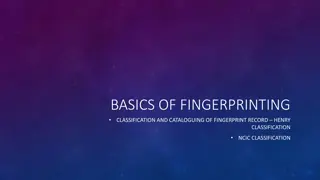
Radar Applications for Smart Infrastructure: Traffic Control and Detection Techniques
Explore the implementation of radar technology in smart infrastructure for traffic control and detection. Learn about radar-enabled solutions for law enforcement, traffic management, and future smart intersections. Discover improved techniques for traffic detection and control, including advancements in radar systems.
Download Presentation

Please find below an Image/Link to download the presentation.
The content on the website is provided AS IS for your information and personal use only. It may not be sold, licensed, or shared on other websites without obtaining consent from the author. If you encounter any issues during the download, it is possible that the publisher has removed the file from their server.
You are allowed to download the files provided on this website for personal or commercial use, subject to the condition that they are used lawfully. All files are the property of their respective owners.
The content on the website is provided AS IS for your information and personal use only. It may not be sold, licensed, or shared on other websites without obtaining consent from the author.
E N D
Presentation Transcript
Smart infrastructure as enabled by radar EECS 725 Radar applications report Bradley Henry
Topics Topics Smart traffic control using radar Smart building control using radar
Smart traffic control enabled by radar Smart traffic control enabled by radar Law enforcement: Speed detection (doppler radar) Wrong-way detection (requires down-the-roadway look angle) Hybrid Visual-Radar system necessary for identification, if necessary for law enforcement actions High traffic thoroughfares (within cities): Traffic light management Advance detection of traffic for >35 mph intersection approaches Lane specific advance detection Queue length detection Gathering of traffic statistics Vehicle type Traffic density Pedestrian/Bicyclist detection
Smart traffic control enabled by radar (cont.) Smart traffic control enabled by radar (cont.) Highway applications: Traffic counting and statistical data gathering Ramp monitoring Accident detection Future smart intersection to car communication: Enabling technology for driver-less vehicles Transmits lane specific data to enabled vehicles Transmits pedestrian/bicyclist information to enabled vehicles Radar advantages over purely visual traffic systems: Immune to weather conditions Immune to variable lighting conditions Anonymous data collection does not gather driver information for traffic control
Improved technique for traffic detection and Improved technique for traffic detection and control control Older systems employed a side-view radar, as in law enforcement doppler radar Newer techniques look down the roadway itself, allowing for more complete vehicle detection and trajectory tracking Similar in principle to the side-looking imaging radar from Dr. Allen s last lecture *smartmicro website
Comparison of continuous wave, frequency modulated continuous wave, and MIMO systems *InnoSenT tech website
Smart Building systems enabled by radar Smart Building systems enabled by radar Relevant applications of radar to smart buildings: Presence detection Detection of heartbeat and respiration by radar allows for improved detection over passive IR or visual systems (which may struggle to identify human objects ) Smart Doors Smart Escalators Temperature control (preventing wasted climate control) Security/Alarm systems Radar detection to wake up power-intensive visual systems Touchless controls Gesture detection
Smart Building systems enabled by radar Smart Building systems enabled by radar (cont.) (cont.) Improvements of Radar-based sensors over strictly visual/IR based systems: Lower energy costs Non-invasive monitoring for privacy Immunity to heat and airborne particle concentration levels (vs. passive IR systems) Hybrid visual/IR/radar systems may present the most benefits Implementation for individual devices: Antenna in package is very typical for these short-range radar applications, having antennas implemented directly on the system PCB along with necessary chips and other components to drive the antennas
Example of a fully integrated short Example of a fully integrated short- -range radar system for use in smart buildings system for use in smart buildings range radar Infineon BGT60LTR11SA Package size: 3.3 6.7 0.56-mm Human presence detection at a range of 0.5m to 6m 61 GHz operating frequency 1.5V supply voltage (allowing operation from battery or electrical grid)
Estimated Smart Home energy savings Estimated Smart Home energy savings *courtesy of IoT World Today website
Credit/Thanks Credit/Thanks The websites, marketing literature, and datasheets comprising the substance of this report are primarily owed to: Traffic sensing and control enabled by radar: InnoSenT technology Smartmicro National Institute for Transportation and Communities Smart buildings as enabled by radar: InnoSenT technology Infineon IoT World Today Imec research 5G Technology World






















